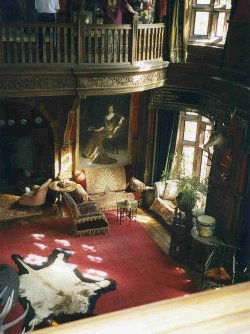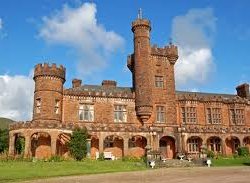The Kinloch Castle Today

After Sir George Bullough’s death in 1939, the Kinloch Castle passed to his wife Lady Monica Bullough who occasionally visited it until 1957. In the very same year, she sold the castle including its contents and the Isle of Rum to the Nature Conservancy. She kept only the Bullough mausoleum where she was buried in 1967, next to her husband and father-in-law, John Bullough who purchased the island in 1888.
Today, the Kinloch Castle is owned and managed by the Scottish Natural Heritage (SNH) that was formed from the Nature Conservancy in 1992. The SNH is aided by the Kinloch Castle Friends Association that was established in 1996 and helps with the promotion of the castle and fund raising for the urgently needed restoration. When acquired by the Nature Conservancy, the castle was already in a neglected state and despite the effort of its current owner to keep it in the best condition possible, it severely deteriorated over the last five decades.

In 2003, the Kinloch Castle was included in the BBC Restoration series and reached the finals but it did not win the competition which would assure its restoration to its former glory. But thanks to the BBC series, the castle attracted a lot of attention including of the Prince of Wales whose Regeneration Trust was asked for a proposal and study for the castle’s future. The Prince’s Regeneration Trust helped in creation of the plan for future development of the castle but the SNH does not have the necessary funds to carry it out. Amongst other, the proposal foresees the closure of the hostel that is in what used to be the servants rooms at the back of the castle. But visitors who would like to spend a night in the Kinloch Castle also have the ability to sleep in one of the Oak rooms featuring four-poster beds.
In addition to serving as a hostel, the Kinloch Castle also serves as a museum which is separated from the hostel which hosts free psychic reading sessions and murder mystery nights. Visitors of the castle can literally step back in time as the castle’s interior remains nearly identical to that from the beginning of the 20th century when it was built. Some of the highlights include various artefacts that were brought there from all over the world by Sir Bullough, personal things of the Bullough family, lavishly furnished and decorated rooms, outstanding woodwork and a wealth of other items which offer a unique insight into the life of the early 20th century social elites. Although the castle reveals serious deterioration and the need for restoration, its visitors do not leave disappointed.
The castle went through a series of restoration works in the last couple of years, however, it is far from being restored. Unless an estimated £8 million (as much as its restoration to its former grandeur is estimated to cost) will be raised, the castle’s owner and manager might be forced to close the castle’s door to the visitors. Hopefully, the necessary funds will be raised within a reasonable time and the Kinloch Castle will continue to astonish its visitors in the future as well.